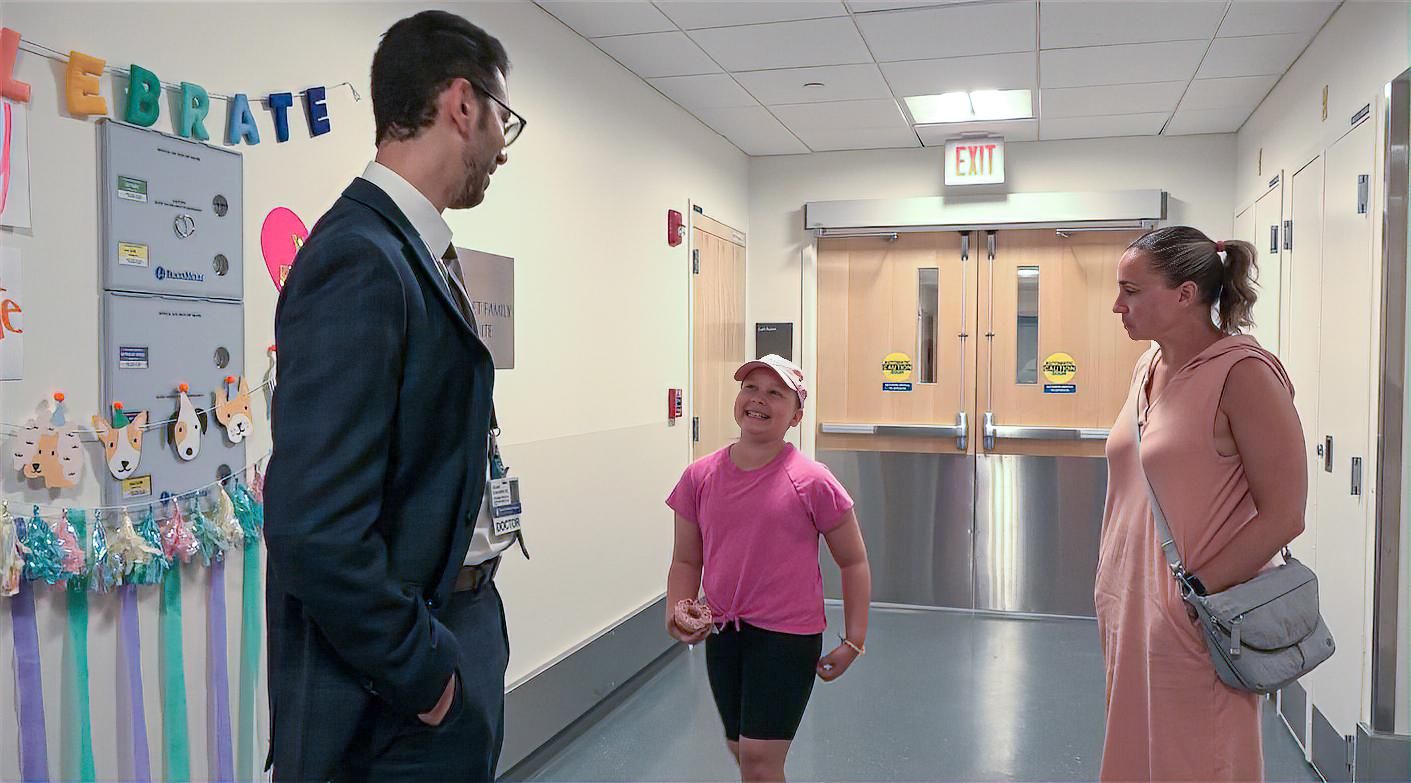Radiating Hope: At 11 Years Old, Youngest Patient to Undergo Novel Radiation Treatment Sees Brighter Days Ahead

Celeste Pardo (center) celebrates the completion of her final radiation therapy session with radiation oncologist Hesham Elhalawani and her mother, Nicole Pardo.
When asked about her cancer diagnosis and the innovative radiation therapy that helped her beat it, Celeste Pardo prefers to focus on the future. “I’m just looking forward to being in school full-time,” she said. “Some kids might feel differently because they don’t really like school, but once you have to skip it, you notice how much fun it is.”
Such insights are not unusual for 11-year-old Celeste, whose mother, Nicole Pardo, says she is quick-witted, honest and “does not hold back” her feelings.
In January 2023, Celeste was having trouble getting over a cough. With a history of cold-induced asthma, Nicole and Dan Pardo decided to bring their daughter to a pulmonologist at Dana-Farber/Boston Children’s Hospital for further evaluation. Testing confirmed there was a more serious diagnosis causing her persistent cough: high-risk pediatric Hodgkin’s lymphoma, a type of cancer affecting the lymphatic system that is more typical in teens and young adults than young children like Celeste.
Just one week after being diagnosed, Celeste began six cycles of chemotherapy infusions that kept her out of school for much of the remainder of fifth grade.
Though not all cases of pediatric Hodgkin’s lymphoma require radiation therapy after chemo, Celeste’s did. The Pardo family met with Brigham radiation oncologist Hesham Elhalawani, MD, MSc, to discuss this important next step in Celeste’s treatment. Working closely with Celeste’s hematologists at Dana-Farber/Boston Children’s Cancer and Blood Disorders Center — Andrew E. Place, MD, PhD, and Angela Feraco, MD, MMSc — Elhalawani recommended they treat Celeste using a technology called MR-LINAC, which allows patients to undergo imaging and radiation therapy simultaneously.
This combination of features is significant because organs move as we breathe and swallow, and even the smallest movement can affect the position of a tumor. Being able to see these movements in real time enables physicians to target treatments more precisely and minimize radiation exposure to healthy tissue.
In 2019, Dana-Farber Brigham Cancer Center became the first cancer center in New England to offer this novel therapy.
“We’re one of the national leaders in adaptive radiotherapy, of which MR-LINAC is just one example,” explained Daphne Haas-Kogan, MD, MBA, chair of Radiation Oncology at the Brigham. “Adaptive radiotherapy can accommodate changes in the patient’s body or changes in the tumor — minute to minute and day to day. It takes personalized radiation oncology to a whole new level.”
An Immediate ‘Yes’
Elhalawani — who partnered with radiation oncologist Veena Venkatachalam, MD, PhD, on Celeste’s treatment plan — explained to the Pardos that her cancer was in the front of her chest, between her continuously moving lungs and beating heart.
“We wanted to cure Celeste with the same efficacy of radiation, but with significantly lower radiation doses to the surrounding healthy tissues, especially her heart, lungs and thyroid gland,” he said. “MR-LINAC allows us to track the target in real time and turn on the radiation beam only when the tumor is within that target.”

Celeste and her sister, Annabelle, enjoy a trip to Disney World in celebration of Celeste completing treatment.
The decision to move forward with MR-LINAC was an immediate “yes” for the Pardos. The only challenge was that their 11-year-old would have to get inside a confining and loud MRI machine for a half-hour every day for 17 days straight, holding her breath during key moments for the best results. If she could do it, Celeste would become the youngest pediatric patient ever to be treated with the MR-LINAC at the Brigham.
Celeste was up for the challenge. She found things to help her to pass the time during treatments, such as talking with child life specialist Sydney Sanford, using noise-cancelling headphones and thinking about the trip to Disney World she would get to take when her radiation was complete.
“It doesn’t hurt at all,” Celeste said. “You might be a little bit startled when the noise comes on, but you don’t feel anything. You just have to try not to fall asleep — that’s how comfortable it is.”
Last month, Celeste completed her final treatment session on the MR-LINAC — a milestone she and her family have already celebrated with that trip to Disney World, as promised.
Elhalawani remains inspired by the entire Pardo family. “Childhood cancer is a very tough experience, and it often casts a shadow on the child and the parents. That was not the case for Celeste and her family,” he said. “Celeste was always smiling and joking, just so excited to advance science and share her story about her journey to a cure.”
As Celeste takes on sixth grade, her parents are helping to spread the word about the exciting new technology that has given them peace of mind about their daughter’s future. “The more kids who can use MR-LINAC and avoid long-term side effects, the better,” said Nicole. “It just requires a little bit of discipline.”
Haas-Kogan is encouraged by this feedback. “After this experience, we will try to standardize MR-LINAC for future pediatric patients,” she said. “Dr. Elhalawani will be one of the lead radiation oncologists in the world to spearhead this effort to expand MR-LINAC more broadly for kids and young adults who would benefit from it.”

Leave a Reply